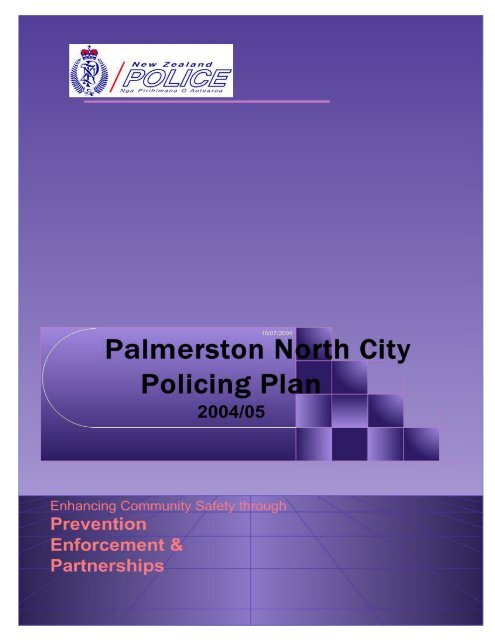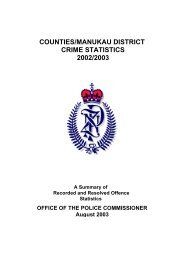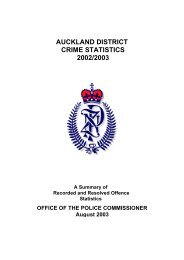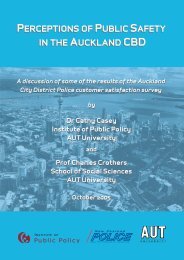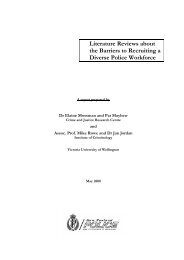Area Policing Plan 2004 / 2005 - New Zealand Police
Area Policing Plan 2004 / 2005 - New Zealand Police
Area Policing Plan 2004 / 2005 - New Zealand Police
You also want an ePaper? Increase the reach of your titles
YUMPU automatically turns print PDFs into web optimized ePapers that Google loves.
<strong>Area</strong> <strong>Policing</strong> <strong>Plan</strong> <strong>2004</strong> / <strong>2005</strong> 1
CONTENTS<br />
Foreword... ..........................................................................................Page 3<br />
Introduction..........................................................................................Page 4<br />
Professionalism and Ethics .................................................................Page 4<br />
Our Community ...................................................................................Page 5<br />
Statement of Purpose. ........................................................................Page 7<br />
Aim and Vision. ...................................................................................Page 8<br />
Goals ...................................................................................................Page 9<br />
Targets ................................................................................................Page 10<br />
Partnerships ........................................................................................Page 11-12<br />
Projects and Partnerships ...................................................................Page 13<br />
Actions.................................................................................................Page 14<br />
Total Crime..........................................................................................Page 15<br />
Burglary ...............................................................................................Page 17<br />
Theft ex Vehicle...................................................................................Page 19<br />
Liquor compliance and Public Place Safety........................................Page 21<br />
Family Violence...................................................................................Page 23<br />
Organised Crime .................................................................................Page 25<br />
Youth Offending and Victimisation ......................................................Page 26<br />
Road Safety.........................................................................................Page 28<br />
Airport <strong>Policing</strong> and Border Control.....................................................Page 30<br />
Responsiveness to Mäori....................................................................Page 31<br />
Youth. ..................................................................................................Page 32<br />
Benchmarking. ....................................................................................Page 33<br />
Organisational Development...............................................................Page 34<br />
Risk Management ...............................................................................Page 35<br />
Appendices..........................................................................................Page 37-39<br />
<strong>Area</strong> <strong>Policing</strong> <strong>Plan</strong> <strong>2004</strong> / <strong>2005</strong> 2
FOREWORD<br />
<strong>Policing</strong> today can seem complex, often clouded through the advent of criminology, sociology, crime sciences,<br />
community orientated policing, problem orientated policing, Intel lead or informed policing and so on.<br />
For police to contribute effectively to crime and crash reduction it is critical to interpret and translate theoretical<br />
information to create practical and effective strategies.<br />
Palmerston North police must work effectively and in collaboration with other key stakeholders to reduce crime<br />
and road crashes and increase crime resolution rates.<br />
This plan provides a clear reference point in terms of what we want to achieve throughout this year – and<br />
provides an outlook of our programme over a three-year period.<br />
The key to success is to ensure that we focus on what is important and ensure that our resources are agile in<br />
responding to community safety issues over which <strong>Police</strong> have some influence.<br />
<strong>Police</strong> must take ownership of issues that come to their attention and ensure that information is shared through<br />
the Intelligence Group mechanism.<br />
Through Intelligence led policing we can target our resources and attentions to defined risks and priorities.<br />
<strong>Policing</strong> by fact ensures that as an organisation we minimise the risk of goal diffusion. (Distraction)<br />
Furthermore <strong>Police</strong> have to regard their role more widely than conventional enforcement. All police should regard<br />
offending in a broad context where we seek both enforcement and prevention solutions to bring about sustainable<br />
crime reduction. Crime prevention initiatives, analysis, problem solving, building effective partnerships, early<br />
intervention and innovation need to be incorporated to all policing activity to reduce the impact of crime and road<br />
trauma.<br />
We are committed to developing a culture that is focused on continuous improvement and results.<br />
Key partner agency and ethnic group partnerships will be valued where there is a commitment to community<br />
safety. In our more recent history Mäori have emerged as an important partner for <strong>Police</strong>. The strengthening and<br />
importance of Iwi must be recognised in terms of what we can collectively contribute to community safety.<br />
Genuine working partnerships that maintain an outcomes focus will produce positive results for our community.<br />
Leadership is not imbued solely to those in our organisation who hold positions of authority. Our culture should<br />
encourage ideas and innovation from all staff and those who hold positions of authority need to be open and<br />
positive to suggestions that may yield organisational and service delivery improvements.<br />
Our culture is not one of mediocrity and it is a collective responsibility to ensure that we intervene early where<br />
poor or unethical performance surfaces among us. Our culture is one where commitment, professionalism and<br />
excellence are recognised.<br />
We need to ensure that we provide training to minimise risk for staff deployed in any operational setting.<br />
Furthermore we need to develop HR policies and practises that allow for individual and team development.<br />
Our community maintains high expectations of what we can and should achieve. They have invested in us so it is<br />
for us to ensure that we contribute positively to meet that expectation.<br />
(Inspector Pat Handcock, <strong>Area</strong> Commander)<br />
<strong>Area</strong> <strong>Policing</strong> <strong>Plan</strong> <strong>2004</strong> / <strong>2005</strong> 3
INTRODUCTION<br />
This plan outlines how the Palmerston North City <strong>Police</strong> <strong>Area</strong> will contribute to the City in the “year”<br />
commencing 1 July <strong>2004</strong>.<br />
We will continue to operate within a Community Orientated <strong>Policing</strong> philosophy and will principally<br />
deliver our service through Intelligence led policing by;<br />
Understanding our social environment and being responsive to our communities<br />
Implementing policing strategies with an emphasis on both prevention and enforcement<br />
Targeting our resources to risk<br />
Establishing and creating productive partnerships<br />
Professionalism and Ethics<br />
<strong>New</strong> <strong>Zealand</strong> <strong>Police</strong> hold a unique position of 'trust' within our communities.<br />
<strong>Police</strong> (Personnel) are entrusted to enforce a wide range of laws and it is critical that all police staff<br />
discharge their duties with the utmost professionalism at all times.<br />
Suspect targeting operations involving recidivist offenders will periodically draw complaint from those<br />
subject to (or associated with) police attention. Threat of complaint intended to sanction <strong>Police</strong> staff<br />
should and will not deter police activities aimed at reducing the offending of known recidivist offenders.<br />
In our dealings with these people we will remain resolute and professional at all times.<br />
The very nature of police work will mean that ethical issues will surface regularly. Ethics are openly<br />
discussed at all levels of our organisation.<br />
Poor, unethical or unprofessional behaviours within our organisation will be proactively dealt with and<br />
will result in staff placement on Performance Management <strong>Plan</strong>s.<br />
Referral and investigation of <strong>Police</strong> Complaint matters will be investigated and reported on within<br />
specified time frames.<br />
<strong>Area</strong> <strong>Policing</strong> <strong>Plan</strong> <strong>2004</strong> / <strong>2005</strong> 4
Our Community<br />
General Summary<br />
Palmerston North is a provincial city located in the lower North Island.<br />
Our geographical location has our city located at the centre of an axis that has contributing areas of<br />
Taranaki, Whanganui, Central plateau, Hawke's Bay, Tararua and Horowhenua.<br />
Although not located on State Highway 1, Palmerston North is a city easily accessible from other<br />
provincial and rural centres located within a 3 hour drive radius.<br />
Palmerston North boasts an International Airport, and tertiary institutions that cater for more than 15,000<br />
students.<br />
Linton Military Camp and the Air Force base at Ohakea also influence Palmerston North in terms of its<br />
unique qualities.<br />
The 2001 Census estimated Palmerston North’s population at 72,366.<br />
Statistics <strong>New</strong> <strong>Zealand</strong> has completed subsequent forecasts for Palmerston North which shows that our<br />
population rose to 77,500 as at June 2003.<br />
Population 78,000 (Est)<br />
Caucasian 85.2% Maori 13.5%<br />
Pacific<br />
Islands<br />
4.5% Asian 9.2% Other 0.7%<br />
Employment and impacting population issues<br />
Palmerston North City has an estimated workforce of 36,270 1<br />
The city also provides employment for many people who live outside its territorial boundary.<br />
Palmerston North City Council statistics reveal that 6,798 jobs are filled by persons commuting into<br />
Palmerston North. (i.e. they live outside the territorial boundary and are not counted in the Palmerston<br />
North City population)<br />
Conversely some 3,255 person's travel out of Palmerston North on to work<br />
.<br />
This results in a daily net gain in population of 3543<br />
Palmerston North has an 8.44% unemployment rate, and young people make up 4.34% of total<br />
unemployment. (1587 persons)<br />
Palmerston North City has a high ratio of young men making up 9.2% of the population. (National<br />
median = 6.65%) 52.2% of the young male population are beneficiaries 2 .<br />
1 Statistics <strong>New</strong> <strong>Zealand</strong> - Census 2001<br />
<strong>Area</strong> <strong>Policing</strong> <strong>Plan</strong> <strong>2004</strong> / <strong>2005</strong> 5
Palmerston North has a large retail industry where all major trading companies are represented. It also<br />
boasts a significant entertainment industry including restaurants, movie theatres, live theatre and a<br />
thriving liquor industry. 3<br />
The city also has the regional hospital servicing Horowhenua, Manawatu, Tararua, parts of Rangitïkei<br />
and Palmerston North.<br />
The region's Mental Health Services are also based within Palmerston North Hospital.<br />
Linton Military Camp features as a significant population entity. The camp and adjacent military<br />
accommodation is home for more than 1,500 personnel.<br />
Linton also accommodates the regional prison housing 278 inmates. (When at full capacity).<br />
2 Source - Victoria University via Office of the Commissioner, <strong>New</strong> <strong>Zealand</strong> <strong>Police</strong><br />
3 In <strong>2004</strong> Palmerston North City Council had issued liquor licenses to 188 businesses. By national standards this rate has<br />
Palmerston North as most licensed city in <strong>New</strong> <strong>Zealand</strong>.<br />
<strong>Area</strong> <strong>Policing</strong> <strong>Plan</strong> <strong>2004</strong> / <strong>2005</strong> 6
STATEMENT OF PURPOSE<br />
The Palmerston North City police exists to reduce crime and road trauma, and thereby enhance<br />
community safety.<br />
<strong>Area</strong> <strong>Policing</strong> <strong>Plan</strong> <strong>2004</strong> / <strong>2005</strong> 7
OUR AIM<br />
A vision is important to our area<br />
Our vision describes the optimal state we will have achieved if we meet all of our goals.<br />
The <strong>New</strong> <strong>Zealand</strong> <strong>Police</strong> vision is...<br />
Safer Communities Together<br />
Palmerston North City (Council) also has a vision. This vision is…<br />
“Together we will make Palmerston North an exciting City in which to live, learn, work and play. Ours<br />
will be a caring community where differences are valued, education, research and knowledge will be our<br />
strengths. Our goal is to be a recognised leader in life long learning. We strive to be creative in work<br />
and skilful in business.”<br />
The Palmerston North City <strong>Police</strong> vision is:<br />
To be widely recognised as a professional organisation<br />
that contributes positively to achieve community safety<br />
through crime reduction and road safety<br />
<strong>Area</strong> <strong>Policing</strong> <strong>Plan</strong> <strong>2004</strong> / <strong>2005</strong> 8
OUR GOALS<br />
To . . . . ..<br />
Reduce overall crime<br />
Reduce burglary<br />
Reduce the incidence theft of vehicles and property from vehicles<br />
Reduce the incidence of disorder and public place violence<br />
Positively influence host responsibility throughout the liquor industry<br />
Reduce the incidence and seriousness of family violence<br />
Reduce repeat victimisation<br />
Effectively target recidivist offenders and organised crime<br />
Enhance road safety for all road users<br />
Reduce the incidence of offending and victimisation for youth<br />
Build <strong>Police</strong> capability through continuous improvement<br />
Build working community partnerships<br />
<strong>Area</strong> <strong>Policing</strong> <strong>Plan</strong> <strong>2004</strong> / <strong>2005</strong> 9
OUR TARGETS<br />
Goal achievement (Desired outcomes) has traditionally led to target setting. In all too many cases<br />
managers set targets that for various reasons are unrealistic and are rarely met. For this plan we have<br />
agreed that we will set minimum reduction percentages which ensures that the targets are attainable –<br />
and the challenge (for us all) is to better those targets for any given period.<br />
In <strong>2004</strong>/05 our area crime targets are<br />
To reduce overall reported crime by 5% or better<br />
To reduce house burglaries by 5% or better<br />
To reduce theft ex cars by 5% or better<br />
To reduce unlawfully taken (stolen) motor vehicles by 5% or better<br />
To reduce violence by 5% or better<br />
To reduce family violence by 5% or better<br />
To reduce repeat victimisation by 10% or better<br />
To increase overall crime clearances/resolution rates annually by 1% or better 4<br />
In <strong>2004</strong>/05 our area road policing targets are<br />
To reduce road accidents by 5% or better.<br />
To reduce our serious crash rate.<br />
To reduce our road fatalities.<br />
To deliver upon our contractual strategic traffic obligations.<br />
To maintain a productivity rate of 1 offence notice per hour or better.<br />
To increase restraint wearing compliance.<br />
To increase helmet wearing compliance.<br />
To reduce median speed on our roads.<br />
4 Our aim is to produce (or better) the 1% resolution rate consecutively over 3-5 year. (E.g. 5+%over 5yrs)<br />
<strong>Area</strong> <strong>Policing</strong> <strong>Plan</strong> <strong>2004</strong> / <strong>2005</strong> 10
Partnerships<br />
Historically <strong>Police</strong> have regarded themselves as 'crime fighters' or law enforcement officers, and have<br />
either by design or default carried the responsibility and a good deal of public accountability for<br />
community safety. There has been a strong emphasis on enforcement to the detriment of prevention.<br />
Studies of enforcement operations targeted to specific crimes suggest that enforcement alone provides<br />
short term benefits for crime reduction.<br />
In 2001 <strong>Police</strong> in Canberra, Australia, executed several operations targeting burglary through 'hot<br />
location' analysis and deployment against known recidivist offenders. (Operation Anchorage)<br />
Whilst the operations were celebrated, subsequent analysis demonstrated that the crime reduction<br />
gains were lost over a relatively short period.<br />
In our recent history there is a growing recognition that <strong>Police</strong> must work with other statutory<br />
organisations, key stakeholders and service providers as they also can contribute to reducing crime and<br />
improving road safety.<br />
Palmerston North City <strong>Police</strong> will work with appropriate groups and organisations executing both<br />
prevention and enforcement initiatives. We recognise that there is a need to balance prevention and<br />
enforcement and that we must create a synergy between both aspects.<br />
In diagram our approach is as follows.<br />
<strong>Area</strong> <strong>Policing</strong> <strong>Plan</strong> <strong>2004</strong> / <strong>2005</strong> 11
<strong>Area</strong> <strong>Policing</strong> <strong>Plan</strong> <strong>2004</strong> / <strong>2005</strong> 12
Projects and Partnerships<br />
A number of projects have been commenced during the 2003/04 year.<br />
The relationship between these projects and external key stakeholders is attached to this document as<br />
Appendix 1.<br />
Current Projects<br />
Prisoner Release programme<br />
Tertiary Student Safety project<br />
Asian/ethnic liaison project<br />
Family Violence programme<br />
<strong>Policing</strong> <strong>Area</strong> Clusters project<br />
Youth Offending Teams development project<br />
<strong>Policing</strong> Excellence programme<br />
Central Business District (CBD) CPTED project (PN City Council)<br />
CCTV Project (PN City Council)<br />
<strong>New</strong> Building project.<br />
LES/NIA Migration project. (Decommissioning of the Wanganui Computer)<br />
<strong>Area</strong> <strong>Policing</strong> <strong>Plan</strong> <strong>2004</strong> / <strong>2005</strong> 13
OUR ACTIONS(<strong>2004</strong>/05)<br />
<strong>2004</strong>/<strong>2005</strong> is to be regarded as year one for the purpose of this plan. From July 2003 Palmerston<br />
North <strong>Police</strong> have been working on a number of strategies to improve police/community capability and<br />
curb the level of reported crime in the following categories.<br />
Burglary (With a major emphasis on house burglary)<br />
Theft ex Vehicle<br />
Public Place violence and disorder offending<br />
Liquor licensing<br />
Family violence co-ordination and repeat victimisation<br />
Organised Crime<br />
Road safety delivery<br />
Building Youth Services capability and partnerships.<br />
Continuous improvement in Intel services<br />
It is intended that Palmerston North <strong>Police</strong> provide continuity with existing strategies for the<br />
<strong>2004</strong>/05 year as these categories (above) of offending are regarded as the most invasive of<br />
crimes and (or) offending and are included to the behaviours of the majority of our offenders.<br />
Several of the categories require significant resource commitment, so reducing offending in<br />
these categories is essential to convert reactive <strong>Police</strong> time to proactive activity.<br />
The following pages provide specific actions and measures relating to each of these categories. The<br />
documented strategic or tactical options are (to a degree) generic and do not represent all actions that<br />
are considered and included to local action plans. 5<br />
5 Action planning is to be used within Palmerston North City as a means of documenting actions, assignment of<br />
responsibility and the setting of timelines and review dates for specific areas of attention.<br />
<strong>Area</strong> <strong>Policing</strong> <strong>Plan</strong> <strong>2004</strong> / <strong>2005</strong> 14
Total Crime<br />
Information – Internal<br />
<strong>Police</strong> -<br />
Intel<br />
Scan/Analyse/Response/Assess<br />
Information External –<br />
Community stakeholders<br />
and partnerships<br />
Enforcement<br />
• Determine appropriate<br />
response through weekly<br />
monitoring and briefing<br />
• Task workgroups<br />
Prevention<br />
• Identify and target known recidivist offenders • Directed patrolling to hot locations<br />
• Prosecution and appropriate bail opposition • Community education programmes throughout hot locations.<br />
• Strict bail compliance checks (DPR) • Appropriate victim advice to reduce risk of repeat victimisation<br />
• DNA and fingerprint programme • Public education through cinema and print media<br />
• Youth strategies<br />
• <strong>Police</strong> operations (Liquor compliance)<br />
• Youth Education programmes delivered<br />
• Build YOTS capability<br />
• Operation 'Juvie' • Promote Operation SNAP<br />
• Build capability and provide relevant information to NHS and<br />
CPNZ<br />
• Prison release project • Tertiary student education project<br />
• Organised Crime Operations • Support/advice to appropriate CPTED projects<br />
•<br />
•<br />
•<br />
•<br />
• CCTV (CBD) Project<br />
Evaluate results daily<br />
Collate weekly<br />
Measure against category<br />
benchmarks<br />
Re-task according to<br />
evaluation<br />
<strong>Area</strong> <strong>Policing</strong> <strong>Plan</strong> <strong>2004</strong> / <strong>2005</strong> 15
Performance Measures<br />
Reported Crime<br />
Reported Crime<br />
14000<br />
14000<br />
12000<br />
12000<br />
10000<br />
10000<br />
8000<br />
8000<br />
6000<br />
6000<br />
4000<br />
4000<br />
2000<br />
2000<br />
0<br />
0<br />
Palmerston<br />
Palmerston<br />
North<br />
North<br />
-<br />
-<br />
Total<br />
Total<br />
Crime<br />
Crime<br />
9517.1<br />
9517.1<br />
FY98- FY99- FY00- FY01- FY02- FY03- TGT<br />
FY98- FY99- FY00- FY01- FY02- FY03- TGT<br />
99 00 01 02 03 04 04-05<br />
99 00 01 02 03 04 04-05<br />
FY98-99<br />
FY98-99<br />
FY99-00<br />
FY99-00<br />
FY00-01<br />
FY00-01<br />
FY01-02<br />
FY01-02<br />
FY02-03<br />
FY02-03<br />
FY03-04<br />
FY03-04<br />
TGT 04-05<br />
TGT 04-05<br />
To reduce total crime by 5% or better during <strong>2004</strong>/05 year. ( 9517 offences)<br />
Target for <strong>2004</strong>/05<br />
To reduce repeat victimisation by 10%<br />
<br />
<br />
Compliance with victims of offences legislation<br />
Compliance with output classes (Statement of Intent) relating to victim notification<br />
<strong>Area</strong> <strong>Policing</strong> <strong>Plan</strong> <strong>2004</strong> / <strong>2005</strong> 16
Burglary<br />
Information – Internal<br />
<strong>Police</strong> -<br />
Intel<br />
Scan/Analyse/Response/Assess<br />
Information External –<br />
Community stakeholders<br />
and partnerships<br />
Enforcement<br />
• Determine appropriate<br />
response through weekly<br />
monitoring and briefing<br />
• Task workgroups<br />
Prevention<br />
• Identify and target known recidivist offenders • Directed patrolling to hot locations<br />
• Prison release programme • Community education programmes throughout hot locations.<br />
• Prosecution and appropriate bail opposition • Appropriate victim advice to reduce risk of repeat victimisation<br />
• Strict bail compliance checks (DPR) • Public education through cinema and print media<br />
• DNA and fingerprint programme • Prevention programmes (Burglary Free) in primary schools<br />
• Youth strategies • Provide relevant information to NHS and CPNZ<br />
• <strong>Police</strong> operations • Promote Operation SNAP<br />
• • Tertiary student education programme<br />
•<br />
•<br />
•<br />
•<br />
Evaluate results daily<br />
Collate weekly<br />
Measure against category<br />
benchmarks<br />
Re-task according to<br />
evaluation<br />
<strong>Area</strong> <strong>Policing</strong> <strong>Plan</strong> <strong>2004</strong> / <strong>2005</strong> 17
Performance Measures<br />
Reported Crime<br />
Reported Crime<br />
900<br />
900<br />
800<br />
800<br />
700<br />
700<br />
600<br />
600<br />
500<br />
500<br />
400<br />
400<br />
300<br />
300<br />
200<br />
200<br />
100<br />
100<br />
0<br />
0<br />
Reduce the incidence of burglary by 5% or better<br />
Reduce repeat victimisation by 10% or better<br />
Compliance with output classes 4 & 5 of the Statement<br />
of Intent<br />
Burglary<br />
Burglary<br />
(Commercial)<br />
(Commercial)<br />
602.3<br />
602.3<br />
FY98- FY99- FY00- FY01- FY02- FY03- TGT<br />
FY98- FY99- FY00- FY01- FY02- FY03- TGT<br />
99 00 01 02 03 04 04-05<br />
99 00 01 02 03 04 04-05<br />
Reported Crime<br />
Reported Crime<br />
1800<br />
1800<br />
1600<br />
1600<br />
1400<br />
1400<br />
1200<br />
1200<br />
1000<br />
1000<br />
800<br />
800<br />
600<br />
600<br />
400<br />
400<br />
200<br />
200<br />
0<br />
0<br />
FY98-99<br />
FY98-99<br />
FY99-00<br />
FY99-00<br />
FY00-01<br />
FY00-01<br />
FY01-02<br />
FY01-02<br />
FY02-03<br />
FY02-03<br />
FY03-04<br />
FY03-04<br />
TGT 04-05<br />
TGT 04-05<br />
Burglary<br />
Burglary<br />
(Dwelling)<br />
(Dwelling)<br />
1133.35<br />
1133.35<br />
FY98- FY99- FY00- FY01- FY02- FY03- TGT<br />
FY98- FY99- FY00- FY01- FY02- FY03- TGT<br />
99 00 01 02 03 04 04-05<br />
99 00 01 02 03 04 04-05<br />
FY98-99<br />
FY98-99<br />
FY99-00<br />
FY99-00<br />
FY00-01<br />
FY00-01<br />
FY01-02<br />
FY01-02<br />
FY02-03<br />
FY02-03<br />
FY03-04<br />
FY03-04<br />
TGT 04-05<br />
TGT 04-05<br />
<strong>Area</strong> <strong>Policing</strong> <strong>Plan</strong> <strong>2004</strong> / <strong>2005</strong> 18
Theft ex Car<br />
Information – Internal<br />
<strong>Police</strong> -<br />
Intel<br />
Scan/Analyse/Response/Assess<br />
Information External –<br />
Community stakeholders<br />
and partnerships<br />
Enforcement<br />
• Determine appropriate<br />
response through weekly<br />
monitoring and briefing<br />
• Task workgroups<br />
Prevention<br />
• Identify and target known recidivist offenders • Directed patrolling to hot locations<br />
• Prison release programme • Vehicle owner education programmes throughout hot locations.<br />
• Prosecution and appropriate bail opposition • Appropriate victim advice to reduce risk of repeat victimisation<br />
• Strict bail compliance checks (DPR) • Public education through cinema and print media<br />
• DNA and fingerprint programme • Prevention programmes (Kia Kaha) in primary schools<br />
• Youth strategies • Provide relevant information to NHS and CPNZ<br />
• Targeted <strong>Police</strong> operations • Tertiary student education programmes<br />
• Evaluate results daily<br />
• Collate weekly<br />
• Measure against category<br />
benchmarks<br />
•<br />
Re-task according to<br />
evaluation<br />
<strong>Area</strong> <strong>Policing</strong> <strong>Plan</strong> <strong>2004</strong> / <strong>2005</strong> 19
Performance Measures<br />
To reduce reported offending by 5% or better<br />
To reduce repeat victimisation by 10% or better<br />
Reported Crime<br />
Reported Crime<br />
2000<br />
2000<br />
1800<br />
1800<br />
1600<br />
1600<br />
1400<br />
1400<br />
1200<br />
1200<br />
1000<br />
1000<br />
800<br />
800<br />
600<br />
600<br />
400<br />
400<br />
200<br />
200<br />
0<br />
0<br />
Theft<br />
Theft<br />
ex<br />
ex<br />
Car<br />
Car<br />
1419.3<br />
1419.3<br />
FY98- FY99- FY00- FY01- FY02- FY03- TGT<br />
FY98- FY99- FY00- FY01- FY02- FY03- TGT<br />
99 00 01 02 03 04 04-05<br />
99 00 01 02 03 04 04-05<br />
FY98-99<br />
FY98-99<br />
FY99-00<br />
FY99-00<br />
FY00-01<br />
FY00-01<br />
FY01-02<br />
FY01-02<br />
FY02-03<br />
FY02-03<br />
FY03-04<br />
FY03-04<br />
TGT 04-05<br />
TGT 04-05<br />
<strong>Area</strong> <strong>Policing</strong> <strong>Plan</strong> <strong>2004</strong> / <strong>2005</strong> 20
Liquor compliance and public place safety<br />
Information – Internal<br />
<strong>Police</strong><br />
Intel<br />
Scan/Analyse/Response/Assess<br />
Information External –<br />
Community stakeholders<br />
and partnerships<br />
• Determine appropriate<br />
response through weekly<br />
monitoring and briefing<br />
• Task workgroups<br />
Enforcement<br />
Prevention<br />
• Rolling operations to target liquor outlets • Directed patrolling to hot locations<br />
• Target high risk individuals and groups • Work with PNCC to advise and support CPTED initiatives.<br />
• Prosecution and appropriate bail opposition<br />
• Work with PNCC and other stakeholders to complete the CCTV<br />
project<br />
• Strict bail compliance checks (DPR) • Public education through cinema and print media<br />
• Enforce local liquor ban for the CBD • Prevention programmes (Kia Kaha) in primary schools<br />
• Continue with Operation 'Juvie' • Tertiary student education programmes<br />
•<br />
• Link Safe City Hosts to Directed Patrol strategies.<br />
(Persons/places)<br />
•<br />
•<br />
•<br />
•<br />
Evaluate results daily<br />
Collate weekly<br />
Measure against category<br />
benchmarks<br />
Re-task according to<br />
evaluation<br />
<strong>Area</strong> <strong>Policing</strong> <strong>Plan</strong> <strong>2004</strong> / <strong>2005</strong> 21
Performance Measures<br />
Reduce Public Place violence by 5% or better<br />
Maintain or increase the number of prosecutions (From 2003/04 year) for breaches of the CBD liquor ban<br />
Complete a minimum of 12 rolling licensing and public place disorder operations during the year. 6<br />
Reported Crime<br />
Reported Crime<br />
450<br />
450<br />
400<br />
400<br />
350<br />
350<br />
300<br />
300<br />
250<br />
250<br />
200<br />
200<br />
150<br />
150<br />
100<br />
50<br />
100<br />
0<br />
50<br />
0<br />
Violence<br />
Violence<br />
Offences<br />
Offences<br />
-<br />
-<br />
Public<br />
Public<br />
Place<br />
Place<br />
287.85<br />
287.85<br />
FY98- FY99- FY00- FY01- FY02- FY03- TGT<br />
FY98- FY99- FY00- FY01- FY02- FY03- TGT<br />
99 00 01 02 03 04 04-05<br />
99 00 01 02 03 04 04-05<br />
FY98-99<br />
FY98-99<br />
FY99-00<br />
FY99-00<br />
FY00-01<br />
FY00-01<br />
FY01-02<br />
FY01-02<br />
FY02-03<br />
FY02-03<br />
FY03-04<br />
FY03-04<br />
TGT 04-05<br />
TGT 04-05<br />
Evidence of performance<br />
Filed action plans for licensing, public<br />
place disorder and Operation 'Juvie'<br />
operations<br />
Attendance and contribution to Safer<br />
Community Council meetings.<br />
Attendance and contribution to Liquor<br />
Liaison Committee meetings.<br />
Business objects performance tracking<br />
and analysis to demonstrate targeted<br />
enforcement and offending reductions<br />
are being achieved<br />
6 Must be documented by ACTION PLAN. Operations to include Youth Services, GDB, Strategic Crime, Community and CIB staff.<br />
<strong>Area</strong> <strong>Policing</strong> <strong>Plan</strong> <strong>2004</strong> / <strong>2005</strong> 22
Family Violence<br />
Information – Internal<br />
<strong>Police</strong><br />
Intel<br />
Scan/Analyse/Response/Assess<br />
Information External –<br />
Community stakeholders<br />
and partnerships<br />
Enforcement<br />
• Determine appropriate<br />
response through weekly<br />
monitoring and briefing<br />
• Task workgroups<br />
Prevention<br />
• Target recidivist and high risk offenders • Proactively support victims of family violence<br />
• Prosecution and appropriate bail opposition or conditions • Community Group assignment as victim contact (risk situations)<br />
• Strict bail compliance checks (DPR) • Appropriate and thorough referral to support agencies<br />
• Community Group assignment to monitor risk offenders • Support and participation in Strengthening Families collaborative.<br />
• Where appropriate assist key agencies in enforcing Court orders • Prevention programmes (Kia Kaha) in primary schools<br />
• Ensure Pol400 reporting is accurate and submission is timely • Support and participation YOTS collaborative<br />
•<br />
• Alignment of social services/victims support/YOTS/<strong>Police</strong> Child<br />
Abuse Team and Family Violence co-ordinator.<br />
•<br />
•<br />
•<br />
•<br />
Evaluate results daily<br />
Collate weekly<br />
Measure against category<br />
benchmarks<br />
Re-task according to<br />
evaluation<br />
<strong>Area</strong> <strong>Policing</strong> <strong>Plan</strong> <strong>2004</strong> / <strong>2005</strong> 23
Performance Measures<br />
Reduce reported family violence by 5% or better<br />
Reduce repeat victimisation by 10% or better<br />
Attain 100% compliance with CSV1 reporting<br />
Community and Criminal Investigation follow-up for all family violence cases determined as high-risk (on the basis of indicators of lethality<br />
contained within Pol. 400 reporting processes.<br />
160<br />
140<br />
Recorded Family Violence<br />
142.5<br />
Reported Crime<br />
120<br />
100<br />
80<br />
60<br />
40<br />
20<br />
0<br />
FY98-<br />
99<br />
FY99-<br />
00<br />
FY00-<br />
01<br />
FY01-<br />
02<br />
FY02-<br />
03<br />
FY03-<br />
04<br />
TGT<br />
04-05<br />
FY98-99<br />
FY99-00<br />
FY00-01<br />
FY01-02<br />
FY02-03<br />
FY03-04<br />
TGT 04-05<br />
<strong>Area</strong> <strong>Policing</strong> <strong>Plan</strong> <strong>2004</strong> / <strong>2005</strong> 24
Organised Crime<br />
Information – Internal<br />
<strong>Police</strong><br />
Intel<br />
Scan/Analyse/Response/Assess<br />
Information External –<br />
Community stakeholders<br />
and partnerships<br />
Enforcement<br />
• Target offenders and prosecute pursuant to participation in<br />
criminal gang legislation<br />
Prevention<br />
• Proactively support victims of organised crime<br />
• Target recidivist and high risk offenders • Community Group assignment as victim contact (risk situations)<br />
• Prosecution and appropriate bail opposition or conditions • Appropriate and thorough referral to support agencies<br />
• Strict bail compliance checks (DPR) • Adhere to multi agency collaborative initiatives<br />
• Proactively investigate all reports of crime associated with<br />
organised crime groups/individuals.<br />
• Participate in Parole Board submissions<br />
• Where appropriate assist key agencies in enforcing Court orders • Zero media profile to be afforded to organised criminal groups<br />
• Maintain open information flow through Intelligence Group<br />
• Whole of policing focus on individuals aligned to organised<br />
criminal groups<br />
• Determine appropriate<br />
response through weekly<br />
monitoring and briefing<br />
• Task workgroups<br />
•<br />
•<br />
•<br />
•<br />
• Alignment of social services/victims support/YOTS/<strong>Police</strong> Child<br />
Abuse and Family Violence co-ordinator.<br />
Evaluate results daily<br />
Collate weekly<br />
Measure against category<br />
benchmarks<br />
Re-task according to<br />
evaluation<br />
<strong>Area</strong> <strong>Policing</strong> <strong>Plan</strong> <strong>2004</strong> / <strong>2005</strong> 25
Youth Offending & Victimisation<br />
Information – Internal<br />
<strong>Police</strong><br />
Intel<br />
Scan/Analyse/Response/Assess<br />
Information External –<br />
Community stakeholders<br />
and partnerships<br />
Enforcement<br />
• Determine appropriate<br />
response through weekly<br />
monitoring and briefing<br />
• Task workgroups<br />
Prevention<br />
• Target recidivist youth offenders through DPR process<br />
• Seek appropriate bail/curfew conditions through prosecution or<br />
FGC process<br />
• Ensure high degree of internal collaboration between Child<br />
Abuse Team, Family Violence Co-ordinator and Youth Services<br />
to identify youths and families at risk.<br />
• Alignment of CYFS/ /YOTS/Strengthening Families/<strong>Police</strong> Child<br />
Abuse and Family Violence co-ordinator.<br />
• Strict bail compliance checks (DPR) • Appropriate and thorough referrals to support agencies<br />
• Maintain open information flow through Intelligence group<br />
• Identify and action appropriate youth offenders for DNA<br />
compulsion procedures<br />
• Support and build YOTS capability through the YOTS strategic<br />
plan<br />
• Youth Education programmes delivered to identified risks (By<br />
area and offending type)<br />
• Drive juvenile voluntary fingerprint programme. • Community Group assignment as victim contact (risk situations)<br />
•<br />
• Consult through Korowai Kahui options for Maori youth safety<br />
projects<br />
•<br />
•<br />
•<br />
•<br />
Evaluate results daily<br />
Collate weekly<br />
Measure against category<br />
benchmarks<br />
Re-task according to<br />
evaluation<br />
<strong>Area</strong> <strong>Policing</strong> <strong>Plan</strong> <strong>2004</strong> / <strong>2005</strong> 26
Performance Measures<br />
100% DNA compulsion process completed for qualifying youth offenders<br />
Voluntary fingerprints<br />
Reducing youth offending by 2% for the performance reporting year.<br />
<strong>Area</strong> <strong>Policing</strong> <strong>Plan</strong> <strong>2004</strong> / <strong>2005</strong> 27
Road Safety<br />
Information – Internal<br />
<strong>Police</strong><br />
Intel<br />
Scan/Analyse/Response/Assess<br />
Information External –<br />
Community stakeholders<br />
and partnerships<br />
Enforcement<br />
• Determine appropriate<br />
response through weekly<br />
monitoring and briefing<br />
• Task workgroups<br />
Prevention<br />
• Target recidivist and high risk drivers • Risk targeted patrolling to high crash or risk locations<br />
• Prosecution and appropriate bail opposition or conditions<br />
• YES road safety programmes delivered to schools as per national<br />
guidelines<br />
• Strict bail compliance checks (DPR) • Engage with PNCC in terms of defining local risks<br />
• Allocate and deliver SA(P) hours to outputs as per LTSA contract • Support/recommend roading design interventions<br />
• Maintain productivity rates as per District benchmarks<br />
• Strict enforcement of 'Boy Racer' legislation<br />
• Usage of District Court process for high ION gathering offenders.<br />
(Imposition of disqualification vs. fines)<br />
• Intervention initiatives for risk drivers who continue to come to police<br />
attention.<br />
•<br />
•<br />
•<br />
•<br />
Evaluate results daily<br />
Collate weekly<br />
Measure against category<br />
benchmarks<br />
Re-task according to<br />
evaluation<br />
<strong>Area</strong> <strong>Policing</strong> <strong>Plan</strong> <strong>2004</strong> / <strong>2005</strong> 28
Performance Measures<br />
Meet monthly hour's delivery targets as per contractual requirements.<br />
Meet annual hour's delivery targets across all delivery outputs.<br />
Meet Central District agreed productivity targets against output categories.<br />
• Restraints 1 ION/TON per hour<br />
• Speed 1 ION/TON per hour<br />
• Drink/drive .1 ION/TON per hour<br />
• Accident promoting offences<br />
1 ION/TON per hour<br />
• 365 day cycle helmet compliance campaign (Achieve same or better productivity from 2003/04)<br />
Complete all national campaigns as per the <strong>New</strong> <strong>Zealand</strong> Road Safety Programme.<br />
Complete all local campaigns in accordance with the requirements of the <strong>New</strong> <strong>Zealand</strong> Road Safety Programme<br />
Dedicated Road <strong>Policing</strong> Group to deliver 50% of strategic traffic hours (per contract)<br />
Evidence of Performance<br />
Reduced road crashes within the Palmerston North City territorial boundary<br />
Reduced injury and fatal crashes<br />
Increase in restraint compliance (Measure LTSA survey)<br />
Reduction of 'mean speed' per LTSA survey.<br />
Reduced drink drivers as per LTSA driver survey<br />
<strong>Area</strong> <strong>Policing</strong> <strong>Plan</strong> <strong>2004</strong> / <strong>2005</strong> 29
Airport <strong>Policing</strong> and Border Control<br />
International flight arrivals and departures have increased significantly at the Palmerston North<br />
International airport.<br />
Border security is a critical component of policing within Palmerston North.<br />
Presently the Airport caters for 32 arrivals/departures per week. During the summer months flights<br />
increase to 40 arrivals and departures.<br />
<strong>Police</strong> obligations to IAATA and border security require that each arrival and departure is resourced with<br />
two armed and trained <strong>Police</strong> staff. This obligation has been covered by the Palmerston North <strong>Police</strong><br />
Community Group.<br />
As Palmerston North is a 'secondary' international airport, international flights are generally scheduled to<br />
arrive/depart early in the morning and late in the evening. This results in a labour intensive operation for<br />
<strong>Police</strong><br />
Year One<br />
• Review all processes and Intelligence capability for airport coverage<br />
• Review rosters for Community Group staff to ensure appropriate coverage for all<br />
arrivals/departures.<br />
• Build intelligence capability and a strong interface with local and national intelligence networks<br />
• Meet all Firearms training requirements for airport personnel<br />
• All new staff rostered to work at the airport are to complete RNZP College 'Airport Course'<br />
• Build relationships with airport security partners - Customs, AVSEC, MAF, Airport Company<br />
Year Two and Three<br />
• Review and prepare resourcing business case to Office of the Commissioner to acquire<br />
staffing to ensure appropriate coverage - in recognition of airport/border control and national<br />
security mandates<br />
<strong>Area</strong> <strong>Policing</strong> <strong>Plan</strong> <strong>2004</strong> / <strong>2005</strong> 30
Responsiveness to Mäori<br />
History<br />
Across Central District, Mäori offending rates remain high at approximately 48.5% of total apprehensions.<br />
Mäori Youth offending is even higher where they account for 56.5% of total youth apprehensions.<br />
This disproportionate representation (in the absence of Palmerston North City statistics) must remain a<br />
concern for <strong>Police</strong> and our wider community.<br />
In recent years, Palmerston North City and Rural <strong>Area</strong> <strong>Police</strong> have worked with Korowai Kahui in<br />
developing a sudden death protocol and more recently have been working to educate community groups<br />
on the topic of 'P' (methamphetamine) abuse. During 2003 all staff within Palmerston North received<br />
training in Mäori sudden death protocol and Tikanga.<br />
Future<br />
Year One<br />
• Continue to attend and support Korowai Kahui<br />
• Continue with Mäori Sudden Death protocol training<br />
• Continue to develop <strong>Area</strong> relationship with District Mäori Liaison officer<br />
• Consult with Korowai Kahui exploring Mäori youth victimisation and offending reduction<br />
programmes<br />
• Align programmes/projects with YOTS and Family Violence projects<br />
• Ensure Youth education programmes are offered to and delivered in 'high needs' schools<br />
Year Two and Three<br />
• Develop and implement Mäori youth strategy with a view of reducing Mäori representation in<br />
adverse social statistics<br />
<strong>Area</strong> <strong>Policing</strong> <strong>Plan</strong> <strong>2004</strong> / <strong>2005</strong> 31
Youth<br />
If <strong>New</strong> <strong>Zealand</strong> <strong>Police</strong> and aligned agencies want to achieve long term crime reduction and improved road<br />
safety the key will be to invest in projects designed to influence social culture through our communities'<br />
young people.<br />
Over the last 12 months Palmerston North <strong>Police</strong> have worked closely with representatives from<br />
Education, Child Youth and Family, and Health to strengthen the nationally mandated YOTS 7<br />
collaboration.<br />
This has resulted in the completion of a strategic plan which sets in place the priorities of the collaborative.<br />
There is a strong alignment between the YOTS strategic plan and this document.<br />
Year One<br />
• Develop partnerships and strategy through the YOTS collaborative<br />
• Through the YOTS collaborative explore Youth at Risk project opportunities<br />
• Seek to align Youth Services with Child Abuse Team and the Family Violence Co-ordinator to<br />
deal with common clients and/or 'at risk' families<br />
• Build effective referral and follow-up processes to ensure risk clients/families receive<br />
appropriate support or intervention.<br />
• Ensure Youth education programmes are offered to and delivered in 'high needs' schools<br />
Year Two and Three<br />
• Align and support Youth at Risk projects to Korowai Kahui strategy<br />
7 Youth Offending Teams<br />
<strong>Area</strong> <strong>Policing</strong> <strong>Plan</strong> <strong>2004</strong> / <strong>2005</strong> 32
Benchmarking<br />
<strong>Area</strong> benchmarking provides <strong>Police</strong> with a clear view of historical offending and this can be used to set<br />
targets for consecutive years.<br />
Crime and crash benchmarks are to be set in accordance with this plan and are administered through the<br />
Intelligence Group.<br />
<strong>Area</strong> performance is reviewed, against category benchmarks, weekly through the<br />
management/strategy meeting held every Tuesday.<br />
Benchmarking needs to be considered in a broader context and Palmerston North has an opportunity to<br />
benchmark against other policing areas that have similar demographic, crime and traffic issues.<br />
<strong>New</strong> <strong>Zealand</strong> <strong>Police</strong> are in the early stages of preparing an <strong>Area</strong> Benchmarking 'Cluster' Project which<br />
has Palmerston North City in a cluster with Dunedin, Hagley/Ferrymead, Hamilton, Hornby, Papanui and<br />
Auckland City.<br />
Interestingly, with the exception of Wellington, the seven policing areas account for all major tertiary<br />
institutions throughout <strong>New</strong> <strong>Zealand</strong>.<br />
Benchmarking needs to be considered in a broad context where we seek improvement opportunities<br />
across all aspects of our organisation.<br />
Year One<br />
• Continue to monitor offending rates (strategic crime and overall crime) on a weekly basis<br />
against self imposed targets.<br />
• Continue to evaluate our performance through District performance management regime.<br />
• Consider and include examples of District 'best practise' to area practice and procedures.<br />
• Modify/implement new strategies to achieve crime and crash reduction.<br />
• Scope national policing <strong>Area</strong> 'Cluster' Benchmarking Project. (Including setting terms of<br />
reference, focus areas and defining desired outcomes against focus areas)<br />
• Commence 'cluster' benchmarking project within Palmerston North City.<br />
Year Two and Three<br />
• Continued participation in District performance management process<br />
• Develop national policing area 'cluster' benchmarking project.<br />
• Seek new innovations/practises through national policing area 'cluster' benchmarking project.<br />
<strong>Area</strong> <strong>Policing</strong> <strong>Plan</strong> <strong>2004</strong> / <strong>2005</strong> 33
Organisational Development<br />
Palmerston North City will use the <strong>Policing</strong> Excellence framework as a guide to achieve organisational<br />
improvement across the seven categories of business excellence 8 .<br />
Year 1<br />
Leadership<br />
Develop Individual Professional Development <strong>Plan</strong>s as part of the performance appraisal process<br />
Provide training for unit/squad 2I/C's to provide leadership depth across our organisation<br />
(Succession planning)<br />
Develop Field Training Officer's to provide mentoring opportunities for all trainee staff.<br />
Develop a permissive leadership style that encourages innovation and ownership of community<br />
safety initiatives.<br />
Strategic <strong>Plan</strong>ning<br />
Develop policing plans that provide a practical framework to improve public safety throughout our<br />
community<br />
Widely use action planning as a means of managing operations and initiatives. Action plans are to<br />
specify ownership of actions, timelines and review dates<br />
Formally review our performance at 6 monthly intervals.<br />
Customer and Market Focus<br />
Clearly identify key partners and service providers<br />
Develop strong relationships with the Palmerston North City Council and in particular City Future<br />
to ensure a strong alignment of community safety strategy<br />
Build relationships with local Iwi to align collective community safety initiatives<br />
Information and Analysis<br />
Develop benchmarking practises to include seasonal variations<br />
Develop <strong>Area</strong> reporting mechanisms that provide a weekly summary of performance against<br />
strategic crime categories and include other offence categories that impact upon total crime rates<br />
Develop strategic analysis capability with the Intelligence Group - through continuous improvement<br />
process<br />
Consistently communicate to all staff the practical application and implications of the resolutions<br />
process and guidelines<br />
8 Using the Baldridge criteria<br />
<strong>Area</strong> <strong>Policing</strong> <strong>Plan</strong> <strong>2004</strong> / <strong>2005</strong> 34
Human Resource Development<br />
It is essential for Palmerston North <strong>Police</strong> to develop our own staff capability so they are prepared and able<br />
to take leadership or supervisory roles<br />
Maintain bi-monthly NCO training days<br />
• To include training component to improve policing practises<br />
• To include exposure to Community Safety theory<br />
• To provide an opportunity to review performance and provide input to future directions for<br />
police.<br />
Development of Individual Professional Development <strong>Plan</strong>s in conjunction with the performance<br />
appraisal process<br />
Regularly review resource allocation and deployment against emerging trends and community<br />
safety risks<br />
Develop a police culture that is agile in responding to emerging trends and community safety risks<br />
Process Management<br />
Review data entry processes/resource allocation to ensure alignment of resources to achieve 24<br />
hour target for entry of all strategic crime data to the NIA database<br />
Regularly review and modify any/all processes to ensure validity in context with today's policing<br />
requirements.<br />
Results<br />
Continued participation in District crime forecasting model<br />
Introduce Traffic and crash forecasting model<br />
Years 2 & 3<br />
Continued participation in <strong>Policing</strong> Excellence Programme.<br />
Risk Management<br />
Palmerston North City has for the last 12 months operated a formal risk management programme.<br />
Risks/and their management are listed in the appendices of this planning document.<br />
Documented risks are assessed and updated on a quarterly basis.<br />
The <strong>Area</strong> Risk Register is appended to this document at Appendix 2<br />
<strong>Area</strong> <strong>Policing</strong> <strong>Plan</strong> <strong>2004</strong> / <strong>2005</strong> 35
<strong>Area</strong> <strong>Policing</strong> <strong>Plan</strong> <strong>2004</strong> / <strong>2005</strong> 36
Appendix 1<br />
<strong>Area</strong> <strong>Policing</strong> <strong>Plan</strong> <strong>2004</strong> / <strong>2005</strong> 37
Appendix 2<br />
Risk Description<br />
Impact<br />
Family Violence 200<br />
House Burglary<br />
(Incidence continues to be above<br />
benchmark)<br />
Theft Ex Car<br />
(Incidence of which remains unpredictable<br />
– high one week and lower numbers the<br />
next)<br />
200<br />
200<br />
Bail conditions compliance 200<br />
Loss<br />
Likelihood<br />
Risk Management Register<br />
Control<br />
Effectiveness<br />
.50 55% 55<br />
RRS<br />
•<br />
•<br />
•<br />
•<br />
•<br />
Mitigation strategy<br />
Family Violence Co-ordinator appointed.<br />
All processes reviewed and changes implemented.<br />
Broad training of staff in new process completed.<br />
100% compliance in reporting of CSI and POL 1060 achieved (November).<br />
High risk offender/victim referrals commenced with Community Group.<br />
• Intel now using clear ‘hot spot’ analysis processes.<br />
• Better deployment to risk areas.<br />
• Utilising community volunteers to disseminate crime prevention material to risk areas.<br />
.75 55% 82.5 • Prison release monitoring.<br />
• Recidivist offender strategies.<br />
• Whole of policing approaches.<br />
• Weekly review.<br />
• Strategies driven by Intel.<br />
• Operations S/Sgt appointed 3/11/2003.<br />
• Covert camera deployment to Ashley Street car park<br />
.75 55% 82.5 • 11 apprehensions to date.<br />
.50 70% 70<br />
• Substantial publicity to use of covert cameras<br />
• Cinema 8 crime prevention project. Commenced early December.<br />
• TXC decreasing.<br />
• Strategies driven by Intel<br />
• Work in progress to ensure processes provide timeliness.<br />
• Drug testing (as part of bail conditions) project commenced. Legal precedents<br />
support this initiative. D/S/Sgt Sheridan and D/Sgt Moffatt assigned to complete this.<br />
<strong>Area</strong> <strong>Policing</strong> <strong>Plan</strong> <strong>2004</strong> / <strong>2005</strong> 38
Risk Description<br />
Impact<br />
Loss<br />
Likelihood<br />
Control<br />
Effectiveness<br />
RRS<br />
Mitigation strategy<br />
Primary Assistance Officer<br />
• Palmerston North City does not have anyone qualified to be the Primary Assistance<br />
Officer (OH&SA) – this is not only PNC but the district.<br />
• Managed by O/C Community Group<br />
Airport management (staffing)<br />
• Two business cases have been submitted previously to OoC. Nil success to date.<br />
Meeting legislative & operational<br />
• OoC currently examining Resource Allocation formulae – which may address this<br />
requirements is difficult due to insufficient<br />
issue.<br />
resources tagged specifically for flight<br />
400<br />
.75 45% 135<br />
• PM City revisiting structure and organisational alignment. Risk Manager to be<br />
arrival/ departure monitoring. Shortfalls are<br />
appointed from existing S/Sgt’s.<br />
made up from Community Group, YAS.<br />
Staff often work split shifts to meet demand.<br />
• S/Sgt Baird has completed draft roster for full consultation on Tuesday 13/01/<strong>2004</strong>.<br />
• Roster to involve community group with support from CIB and 2 x Youth Aid Staff.<br />
• Continued use of jailers to mitigate prisoner management risks.<br />
Watchhouse Prisoner and staff safety<br />
• Preliminary work commenced to introduce DAO prisoner assessment form. (to<br />
Usage of Jailers to monitor ‘at risk<br />
prisoners’<br />
200<br />
.75 55% 82.5 provide written record of DAO visit and recommendations. This is being consulted<br />
with Mid Central Health. Expected to be implemented early in <strong>2004</strong><br />
• (S/Sgt Thurston)<br />
Typing Services – workload fluctuations 100 .75 55% 41.25 • Monitoring and management through D/S/Sgt and Senior Sergeant White.<br />
<strong>Area</strong> <strong>Policing</strong> <strong>Plan</strong> <strong>2004</strong> / <strong>2005</strong> 39


